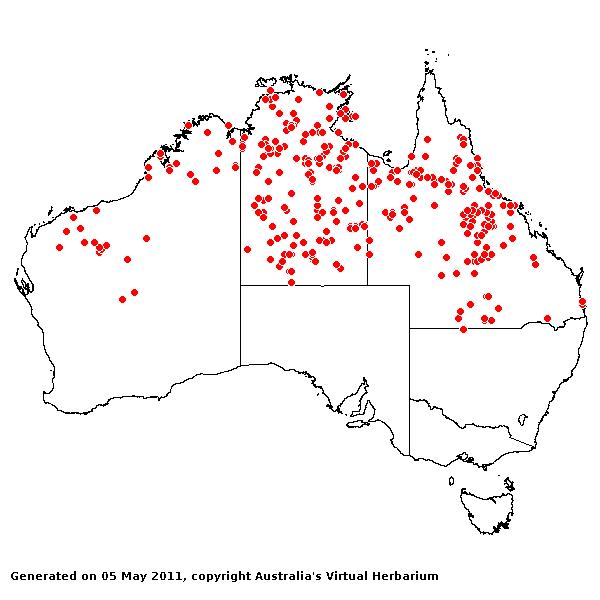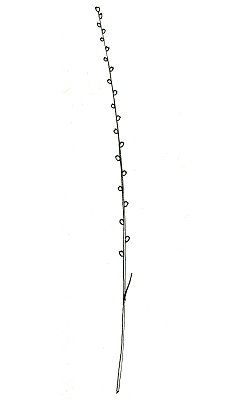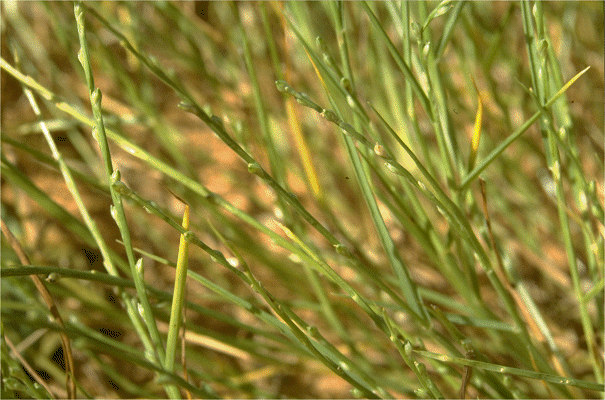Paspalidium rarum (R.Br.) D.K.Hughes. Bull.
Misc. Inform. 318 (1923).
Classification. (GPWG 2001) : Subfamily
Panicoideae. Paniceae.
Basionym and/or
Replacement Name: Panicum rarum
R. Br., Prodr. 189 (1810).
Type of Basionym or
Protologue Information: HT: R. Brown 6100, 1803, Australia (BM; IT:
US-80953 (fragm.)).
Key references
(books and floras): [1810]. R.Brown, Prodromus (189 as Panicum
rarum), [1878] G.Bentham, Flora Australiensis 7 (473 as Panicum
rarum), [1952] C.A.Gardner, Flora of Western Australia 1 Gramineae
(250), [1981] M.Lazarides in J.Jessop (ed)., Flora of Central Australia
(479), [2002] D.Sharp & B.K.Simon, AusGrass, Grasses of Australia,
[2008] S.W.L.Jacobs, R.D.B.Walley & D.J.B.Wheeler, Grasses of New South
Wales (325).
Illustrations:
[2008] S.W.L.Jacobs, R.D.B.Whalley & D.J.B.Wheeler, Grasses of New South
Wales, 4th edn (325).
Habit. Annual.
Rhizomes absent. Culms erect or geniculately ascending or decumbent, 15–45 cm
tall, 3–10 -noded. Mid-culm internodes hollow. Lateral branches sparsely
branched or fastigiate. Ligule a fringed membrane or a fringe of hairs.
Leaf-blades flat or conduplicate, 3–19 cm long, 1–3.5 mm wide. Leaf-blade
surface scabrous.
Inflorescence.
Inflorescence solid, a raceme. Racemes 10–20, appressed, 0.3–0.9 cm long, 3–4
mm wide, bearing 1–3(–4) fertile spikelets on each. Central inflorescence axis
5–13 cm long.
Spikelets.
Spikelets sessile. Involucre composed of bristles. Fertile spikelets 2-flowered,
the lower floret barren (rarely male), the upper fertile, comprising 1 basal
sterile florets, comprising 1 fertile floret(s), without rachilla extension,
ovate, laterally compressed or dorsally compressed, 2.7–3.5 mm long.
Glumes.
Glumes dissimilar, thinner than fertile lemma. Lower glume ovate, membranous,
without keels, 5–7 -nerved. Lower glume surface glabrous. Lower glume apex
muticous. Upper glume elliptic, 2.7–3.4 mm long, membranous, without keels, 7–9
-nerved. Florets. Basal sterile florets 1, barren, without significant
palea. Lemma of lower sterile floret 100 % of length of spikelet, membranous,
5–7 -nerved.
Fertile lemma 2.5–3.5
mm long, without keel. Lemma apex mucronate.
Continental
Distribution: Australasia.
Australian
Distribution: Western Australia, Northern Territory, Queensland, New South
Wales.
Western Australia:
Gardner, Fitzgerald, Hall. Northern Territory: Darwin & Gulf,
Victoria River, Barkly Tableland, Central Australia North. Queensland:
Burke, Cook, Gregory North, Leichhardt, Mitchell, North Kennedy, South Kennedy,
Warrego, Gregory South, Maranoa. New South Wales: North Far Western
Plains.
Notes.
The inflorescence of this species is unique, typically the lateral branches are
reduced to a single spikelet. The spikelets are biseriate on the main axis.
This arrangement is also found in species of Stenotaphrum.
In tropical and
subtropical sub-humid woodlands, semi-arid shrub woodlands, acacia shrublands,
arid tussock grasslands, arid hummock grasslands, and tropical sub-humid
grasslands. Flowers mostly Feb.-July.




